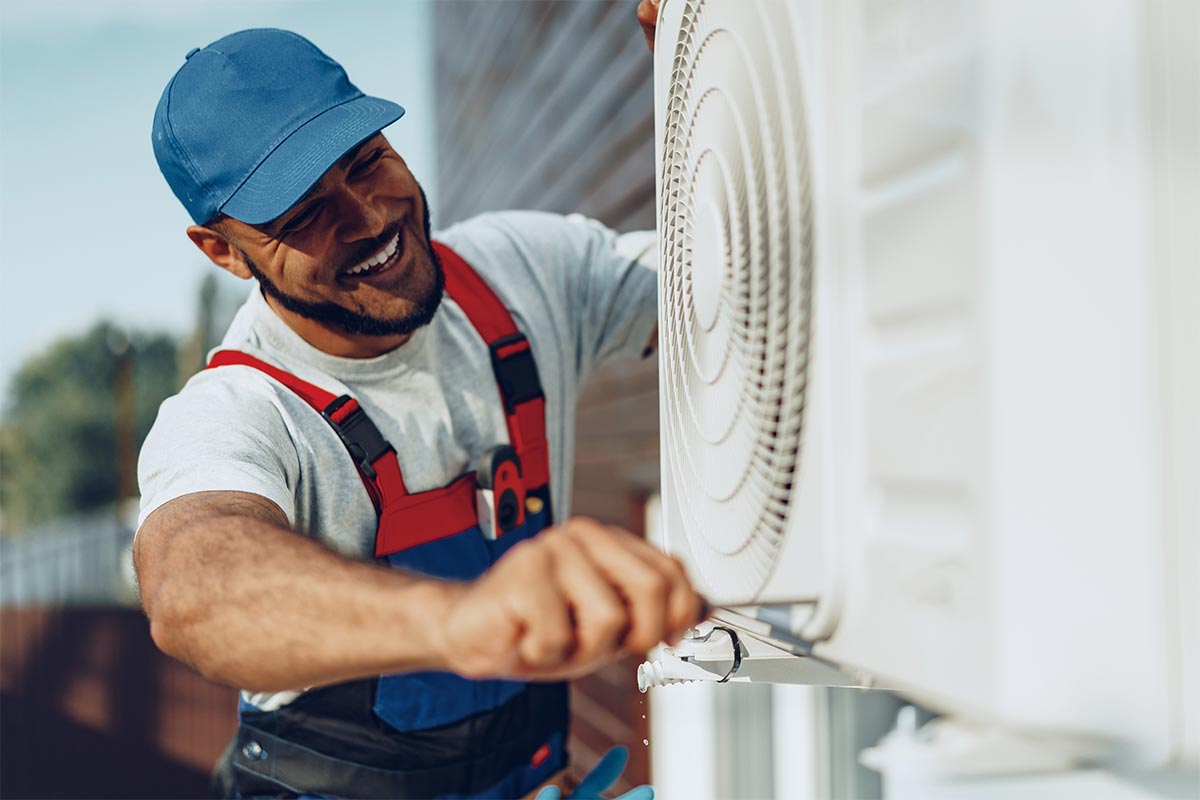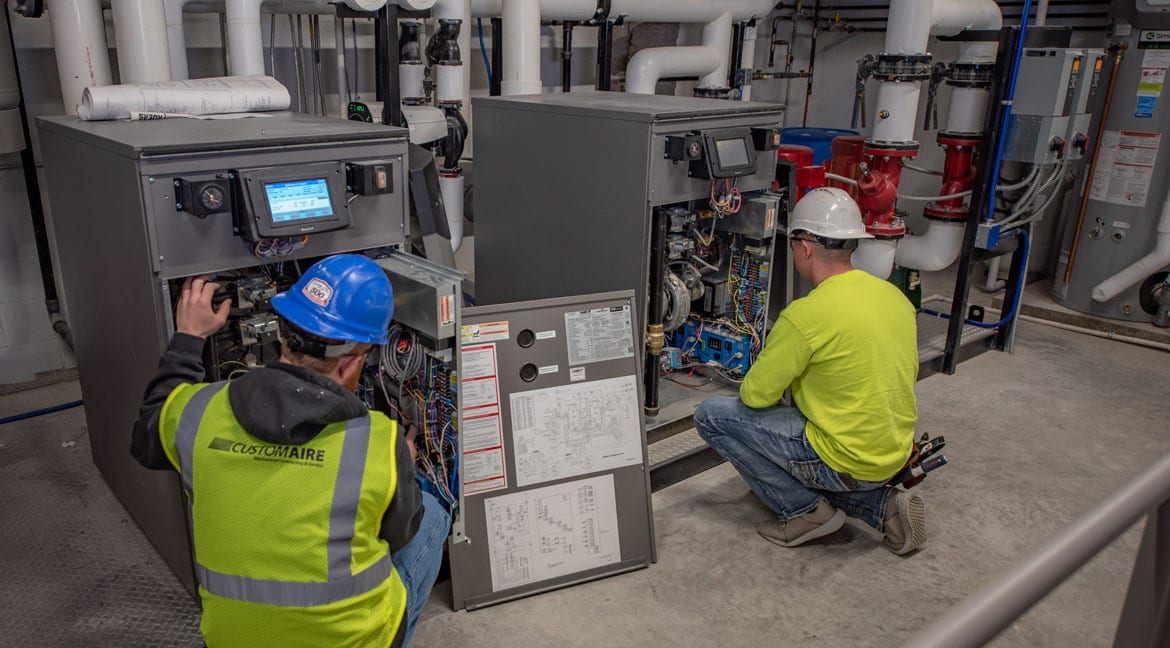Get the Best Results from Your heat pump installation ooltewah tn
Get the Best Results from Your heat pump installation ooltewah tn
Blog Article
Exactly How a Heat Pump and Heating System Collaborate to Maximize Your Home's Heating Effectiveness
Comprehending just how a heat pump and furnace interact is essential for home owners looking for reliable home heating solutions. Each system has its toughness, providing a balanced approach to home comfort. The warm pump masters moderate temperatures, while the furnace supplies fast warmth during severe cold. This synergy not just minimizes energy expenses yet also improves the lifespan of both home appliances. What aspects influence this collaboration, and just how can property owners maximize their benefits?
Recognizing Heat Pumps: How They Work
Although lots of people may be strange with their internal workings, warm pumps play a vital role in contemporary heater. These gadgets run by moving warm from one place to another, using the principles of thermodynamics. In chillier months, a heatpump extracts warm from the outdoors air, ground, or water, and transfers it inside your home to warm up the home. Conversely, throughout warmer months, it can reverse the process, working as an a/c by expelling warmth from inside to the outside.Heat pumps contain an evaporator, compressor, condenser, and development shutoff. The cooling agent within the system takes in warm as it evaporates at reduced temperatures and stress. The compressor then raises the stress and temperature of the refrigerant, permitting it to release warmth as it condenses. This efficient procedure can greatly lower power usage contrasted to standard home heating approaches, making heatpump a sustainable choice for environment control in homes.
The Role of Furnaces in Home Home Heating
Heating systems play an important duty in home heating by giving a trustworthy resource of warmth throughout the cooler months. They run by generating heat with combustion or electric resistance, distributing it throughout the home through ducts or radiant systems. The effectiveness of a heater is frequently determined by its Annual Gas Usage Effectiveness (AFUE) score, which shows exactly how effectively the system transforms fuel into heat.Furnaces can use various energy sources, including gas, electricity, oil, or lp, enabling house owners to choose one of the most suitable alternative for their requirements. Unlike heatpump, which may battle in severe chilly, furnaces preserve consistent efficiency, making sure that interior temperature levels stay comfy no matter of outdoor conditions. In addition, contemporary heating systems frequently come outfitted with sophisticated innovation, such as wise thermostats and variable-speed blowers, improving their performance and responsiveness. This convenience makes heating systems an essential component in comprehensive home heating approaches.

Advantages of Utilizing Both Equipments With Each Other
Combining the toughness of both furnaces and heatpump can bring about a more effective and efficient home heating solution. Utilizing both systems enables house owners to benefit from the heatpump's energy efficiency throughout milder temperature levels while counting on the heater for more severe cold conditions. This double strategy can greatly reduce power expenses, as warm pumps consume less electrical energy than typical heating techniques when temperature levels are moderate.Additionally, making use of both systems with each other can enhance convenience degrees in the home. Warm pumps can provide consistent, even heating, while furnaces can promptly increase ambient temperature levels when needed. The combination of both systems can expand the life-span of tools by reducing wear and tear on each system, as they share the workload. Ultimately, homeowners can appreciate a balanced, affordable heating service that readjusts effortlessly to varying climate condition, guaranteeing a cozy and welcoming home throughout the cold weather.
How Warm Pumps and Furnaces Complement Each Various Other
When property owners incorporate heatpump and heaters, they produce a corresponding furnace that takes full advantage of efficiency and comfort. Warmth pumps run by transferring warm from the outside air or ground, making them very reliable in moderate climates. They excel during milder temperature levels, offering cost-efficient home heating. On the other hand, heaters create warmth with combustion or electrical resistance, supplying solid, immediate warmth during extreme chilly conditions.The mix of these two systems enables dynamic changes based upon temperature fluctuations. During warmer months or milder winter days, the warm pump can take the lead, preserving power and lowering prices. As temperature levels decrease, the heating system can seamlessly involve, making certain constant warmth throughout the home. This harmony not only optimizes power use however also enhances the life-span of both systems, as each unit runs within its optimal performance variety. With each other, they develop a well balanced environment that adapts to varying climate demands.
Optimizing Effectiveness: Tips for Homeowners
House owners can improve Click This Link their home heating efficiency with several useful approaches. Establishing a regular upkeep timetable, integrating smart thermostat innovation, and implementing efficient insulation and sealing options are key steps. These measures not just boost convenience however additionally decrease power prices.
Normal Maintenance Schedule
To assure maximum heating efficiency, developing a routine maintenance schedule is essential for any kind of home. House owners need to focus on routine assessments of both warmth pumps and heaters to determine peak performance. This includes transforming air filters every one to 3 months, as clogged her explanation filters can considerably minimize efficiency. In addition, scheduling expert maintenance at the very least yearly allows professionals to recognize and resolve prospective concerns prior to they rise. Home owners need to additionally clean the heatpump's exterior device to stop debris build-up that can prevent airflow. By sticking to a regular upkeep schedule, property owners not just boost their heating unit' effectiveness however likewise prolong their lifespan, bring about higher comfort and lowered energy prices throughout the cooler months.
Smart Thermostat Assimilation
Incorporating a wise thermostat right into a home furnace can substantially boost power performance, particularly as it permits exact control over temperature settings. These tools can learn the house owner's timetable and preferences, instantly changing the temperature level to optimize convenience while minimizing power usage. For example, they can lower heating throughout times when the home is vacant, decreasing unnecessary usage. Several smart thermostats also provide real-time power use information, making it possible for home owners to make enlightened decisions concerning their home heating behaviors. Furthermore, remote accessibility through mobile phone applications enables users to change settings from anywhere, ensuring the home is cozy upon return. Overall, clever thermostat integration not just improves comfort but significantly contributes to power savings and efficiency.
Insulation and Sealing Solutions
Smart thermostats play a critical function in power performance, however their effectiveness can be substantially enhanced by correct insulation and securing services. Homeowners ought to focus on shielding floors, walls, and attic rooms to reduce warmth loss. High-grade insulation materials, such as spray foam or fiberglass, can considerably enhance thermal resistance. Furthermore, securing gaps around doors, home windows, and air ducts avoids chilly air infiltration and warmth getaway. Weatherstripping and caulking work methods for dealing with these leakages - heat pump service. Normal evaluations for air leakages, along with using blower door examinations, can aid determine issue locations. By investing in insulation and securing, house owners can optimize the performance of their heating unit, eventually leading to lowered energy usage and reduced utility costs
Common Myths About Warm Pumps and Furnaces
What false impressions surround warm pumps and heaters? Lots of individuals wrongly believe that heatpump are ineffective in chillier climates. In reality, modern-day warmth pumps are developed to run efficiently even in reduced temperatures, providing trusted heating throughout winter months. Another usual misconception is that furnaces are always much more effective than heatpump. This depends on the particular energy sources and efficiency rankings of the devices in concern. Some may also assume that using both systems at the same time is unnecessary, however as a great post to read matter of fact, this mix can optimize home heating effectiveness, especially during extreme weather conditions. Furthermore, people frequently assume that warm pumps call for continuous maintenance, when actually, they have similar maintenance needs to typical home heating systems. By disproving these myths, house owners can make more informed decisions regarding their home heating alternatives, inevitably bring about improved comfort and energy performance in their homes.
Maintenance Considerations for Combined Systems

Often Asked Concerns
Can Warm Pumps Job Effectively in Extremely Cold Climates?
Heat pumps can battle in very cold environments because of minimized effectiveness and warmth removal limitations. Advancements in technology have led to versions created for better efficiency in such conditions, improving their practicality in harsh environments.
Just How Lengthy Do Warm Pumps and Furnaces Usually Last?
Heatpump normally last 15 to 20 years, while furnaces have a life-span of 15 to 30 years. Routine upkeep can extend their long life, ensuring efficient operation and reducing the need for premature replacements.

What Is the Average Cost of Putting Up Both Equipments?
The typical price of setting up both a heatpump and a heating system commonly ranges in between $5,000 to $10,000 - furnace replacement. Variables affecting this cost include system size, setup intricacy, and local labor prices
Are There Tax Incentives for Making Use Of Energy-Efficient Heating Equipments?
Numerous property owners make inquiries about tax incentives for energy-efficient heating unit. Different federal and state programs usually supply refunds or credit histories, urging the fostering of lasting technologies to reduce energy consumption and promote ecological obligation.
Just how Do I Pick the Right Dimension Warmth Pump and Heating System?
Picking the ideal dimension warm pump and heating system includes computing the home's square footage, considering insulation top quality, and evaluating local environment. Consulting a professional can assure optimal system performance and power efficiency based on particular needs. heat pump installation ooltewah tn. Recognizing exactly how a heat pump and furnace job together is essential for property owners seeking reliable home heating services. In chillier months, a warm pump removes heat from the outside air, ground, or water, and transfers it inside your home to warm up the living room. When property owners integrate warmth pumps and heaters, they produce a complementary home heating system that makes best use of effectiveness and comfort. Warm pumps run by moving heat from the outside air or ground, making them extremely efficient in moderate climates. Warmth pumps can have a hard time in extremely cool climates due to decreased performance and warmth removal restrictions
Report this page